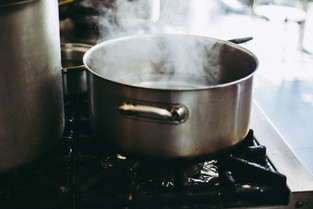Which Pot or Pan do I use.... And Why?
- Chef Savant

- Mar 19, 2020
- 5 min read
Updated: Mar 15, 2021
Discover the differences between pots and pans. Learn how to use them and why the weight and material affect how they cook, and why!

You may have noticed while watching your favorite food channel or cooking show that chefs will use different pans to cook different dishes. Maybe they use a cast iron skillet to cook a burger or to sear a steak instead of a grill. Or maybe you’ve seen someone use a copper pan instead of stainless steel sweat vegetables or make sauces. But why do they do it? Does it really make a difference?
How do chefs keep up, what does it all mean, and how can you level the playing field in your own kitchen? Well, for starters it helps to know what the differences are between the two styles of cookware, as well as what they’re used for.
Pots vs. Pans
In the true fashion of keeping our explanations simple, a basic rule of thumb is that pots are usually taller in size and used for more liquid applications and pans are usually wider, being use more high heat applications. Now again, this is only a rule of thumb, and should not be considered a universal rule.
Pots on the other hand, are generally used for items that use a more moist/gentle heat application such as: boiling, simmering, slow cooking, or braising. etc and are are often seen used for tasks like boiling pasta, simmering stews, making stocks/broths or, braising items to create a moist and tender finish.
Pans are generally used for the more high heat applications. such as: browning, toasting, charring, searing, frying, and sautéing, just to name a few. Woks are kind of a hybrid and can be seen to bridge the gap between the two classes of cookware, as they can be used for both the more gentle heat or some of the high heat applications.
So now that we know the difference in the two types of cookware, and their uses in cooking, lets get some perspective on when and why to use them in our food preparations. Each method is supported by a certain type of heat output, and that output is controlled, in part, by the type of material the cookware.
Cast iron for example is used best used for high heat applications, because too much moisture can affect the iron and create issues with the integrity of the pan, causing it not to perform properly. So if you’re planning to do a deep sear on a piece of chicken or steak to develop a deep browning or to get a good char, cast iron will be the winner. That being said, the browning process can add a lot of flavor to an item. In fact, some chefs will forgo the presentation of nice grill marks and use a flat cast iron griddle for more surface area browning and unforgettable flavors. Arguably though, some of the best smokers and grills, use cast iron materials for its ability to conduct and maintain high levels of heat which work great for trapping flavors and locking in moisture.
Stainless steel and aluminum pans are often used by restaurants for sautéing foods because they heat up fast, and offer a fair amount of caramelization without imposing a deep char, the way that cast iron does. It also responds well to the heat adjustments so that the residual heat is controlled a bit easier allowing for more time to manage flavors without compromising texture. In other words, if you need to start and item on the stove top but finish it in the oven, either of these materials would more readily adjust to the change in heat temperature, instead of maintaining the heat for a longer time span like cast iron. Of course, aluminum tends to release heat a bit faster than stainless steel, which allows the foods to “rest” quicker, without too much carry over cooking.
Copper can be a bit tricky, as it is not only more costly but is also considered a more reactive material when sing acidic ingredients. More often than not, copper gets used in the form of sauce pots and the occasional sauté pan, but not really a pan for frying chicken or making fries. Because of the way it conducts heat chefs love to use copper pots for things like soups and sauces and other gentle heat application. The reason for this is that it distributes heat more evenly around the base and walls of the cookware, which reduces the chances of scorching sauces as they reduce and concentrate liquids. Its not uncommon to find pots made of stainless steel with copper coating to offer better heat retention and distribution, while reducing the chance of the copper reacting harshly with anything acidic foods in the food. Clever right?
Porcelain is another great kitchen addition to keep around. It‘s most often recognized as crock pots or dinner plates because, like copper, it plays well with moisture management, but it also maintains heat to keep hot foods hot! But unlike copper, porcelain can be adapted to coat materials like cast iron to give your the best of both worlds, offering high heat resilience, while lending the moisture of gentle heat applications. And while you wont be doing much searing or charring with porcelain, with enough time you can get pretty good growing and caramelization for flavor development with little worry of burning your food. At times you may find glass pans can be used in place of some porcelain applications when baking or using other gentle heat applications.
Conclusion...
At this point we’ve gone over the differences between pots and pans, some of their heat applications and a few of the more popular materials that can be found in most everyday kitchens. So now lets review some of the best times to use them.
Cast Iron.. Good for:
Searing, Browning, Charring
Also good for baking cornbread, making pancakes, frying chicken, french fries, spaghetti sauces, rolls, and some desserts like cobblers, and bread puddings.
Copper... Good for:
Making soups and sauces, simmering and sautéing, sweating vegetables, as well as cooking beans, greens, or potatoes, but not tomatoes. 😉
Porcelain... Good for:
Good for slow cooking, sweating items or gently browning, (because of the moisture factor, it will brown/sear a bit differently than cast iron, and will offer less char to the food). It’s also good for quiches, casseroles, and oven baked items.
Glass... Good for:
Almost exclusively used as a pot, instead of a pan, because of how it conducts heat and moisture, similar to porcelain. Cooking uses include: cooking rice or pasta, making tea, baking casseroles, or reducing sauces.
In a later post, we’ll discuss some simple tips about how to avoid misapplications of certain cooking techniques and we’ll also discuss how to get maximum flavors with minimal effort.

















Comments